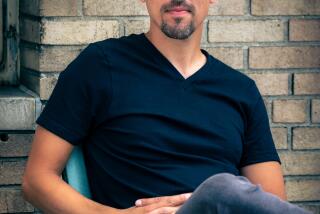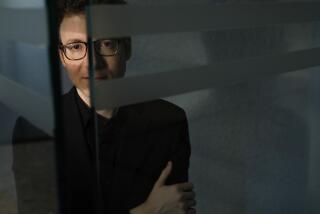He’s All Keyed Up Over the Accordion
- Share via
Nick Ariondo wears his accordion on his sleeve.
The composer-musician’s attitude is understandable. Although the accordion is given reverential status in much of world music, Americans tend to relegate the instrument to a trailer-park polka status. The list of accordion-friendly locales is long: Latin America, Scandinavia, Switzerland, Ireland, Hungary, Bulgaria, France, Cuba, Africa.
Ariondo is determined to change the way Americans think about the accordion, and he has a lot of local standing ovations to prove that we might just be ready to listen.
At a Sundays Live program at the Los Angeles County Museum of Art’s Bing Auditorium (broadcast live over KMZT) in November, Ariondo brought a capacity crowd to its feet with his blistering arrangement of Ernesto Lacuona’s “Malaguena.”
The audience was noticeably spellbound by his accordion playing on Manuel de Falla’s “Dance Espagnole” and the familiar “Seguidilla” from Bizet’s “Carmen.”
“The initial response when people come up to me after a performance is, and I’m not bragging here, is that they’re amazed at what they heard come out of the instrument,” Ariondo says. “Amazed at what I could do with the accordion.
“In ‘Maleguena,’ the way I set the arrangement up, in the middle section, I start playing a left-hand run on the buttons. Then, with my right hand, I’ll start tapping the bellows, the grille, anything to make a percussive effect. I treat the accordion as a percussive instrument as well as a musical one.”
LACMA audiences don’t usually clap in time. That time they did.
Ariondo’s expertise in interpreting the world repertoire of accordion music has been acknowledged by critics in publications as diverse as Holland’s Accordeonkrant and the Armenian Observer. New Times’ Johnny Angel wrote, “Never again will this listener giggle at the mention of the accordion.”
Ariondo claims he is as comfortable with the tango as he is with jazz and rock. He doesn’t mind mixing genres in his own compositions. He’ll play anywhere he can in an effort to convince people of the versatility of the accordion.
“I want to bring the accordion into the 21st century,” says Ariondo. “I want to put it on a pedestal.”
He knows that even those who aren’t fond of the earthy coarse sound of the instrument can be taught to forget Lawrence Welk.
Possibly the hardest-working accordionist in town, Ariondo divides his time among private parties, concert appearances, club dates and solo performances at private clubs.
He eats, drinks and thinks accordion. He can dash from a proper afternoon concert with his Nick Ariondo Chamber Orchestra to a cabaret gig with slightly off-kilter chanteuse Suzy Williams at Genghis Cohen or Cinegrill.
He won 10 consecutive ASCAP awards between 1987 and 1997 for arranging and composing. He is director of Accordion Studies at Cal State L.A., his alma mater.
“If I’m lucky, I get one or two students,” he says, ruefully. “There aren’t that many young accordionists coming up. The schools don’t take it seriously.”
Ariondo was born in Pittsburgh, a city that knows its way around the accordion. His Italian heritage landed right in the middle of an ethnic respect for the instrument and it wasn’t until he got out of the neighborhood that he realized that the accordion wasn’t as beloved in the outside world. His disbelief continues to this day.
Admittedly, one can hardly imagine a Paris street scene without a lilting accordion musette in the background. Gypsy violins seem empty with out the accordion or its relative, the bandeon.
Ariondo thinks the accordion is taken for granted as a background instrument, so he composes and arranges music that puts his instrument in the foreground. In his “Tango Indo-Serene,” a dreamy Indonesian-influenced tango, the accordion gently weeps. In “Gypsy Fantasy” (Duo for Two Stars), a composition he wrote for Violinist Igor Tamarin, a solo accordion leads the first half.
A cello is softly introduced, and by the end of the piece, both instruments join in a wild frantic union.
“Through my many years of studying and experimenting with various styles,” Ariondo says, “ . . . from early classical to modern contemporary, I’ve developed a musical language and vocabulary that has now become my very own.
“My whole concept is to create something very new and different for the accordion.”
Although Ariondo is dead-serious about accordion music, his dry wit comes very much into play when he accompanies Williams. Her saucy renditions of torch songs by the likes of Cole Porter, Jack Kerouac and Kurt Weill as well as her own songs give him a chance to play foil for the coquette.
His ability to move easily from solo performer to accompanist makes Ariondo a much-sought-after player with other performers.
He has appeared with the Hollywood Bowl Orchestra, the Los Angeles Music Center Opera and PBS’ “Classic Arts Showcase” series. He performed last summer at the Getty with members of the UCLA Wind Ensemble at “Atget’s Paris: Music from the Street to the Opera House.”
Ariondo’s technical prowess, creative and original compositions and willingness to let his accordion speak many languages may gain him a wider audience soon.
Americans let Lawrence Welk into their living rooms. Nick Ariondo could fill the house.
*
* Nick Ariondo performs Monday with Suzy Williams and vibraphonist Kahlil Sabbagh at Genghis Cohen, 740 N. Fairfax Ave., Los Angeles, 8 p.m., $10 cover (323) 653-0640. He also performs solo at May 6 at First Unitarian Church of Los Angeles, 2936 W. 8th St., Los Angeles, 3 p.m., $10, (213) 389-1356.
More to Read
The biggest entertainment stories
Get our big stories about Hollywood, film, television, music, arts, culture and more right in your inbox as soon as they publish.
You may occasionally receive promotional content from the Los Angeles Times.










